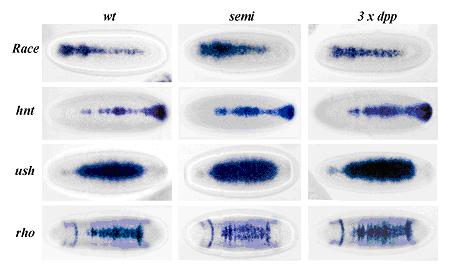つくば生物ジャーナル Tsukuba Journal of Biology (2004) 3, XX (C)2004 筑波大学生物学類
SUMO protein represses Dpp signaling during the early development of Drosophila melanogaster
武田 修学 (筑波大学 生物学類 4年) 指導教官: Hilary Ashe (School
of Biological Sciences, The University of Manchester, UK (exchange program))
In the Drosophila melanogaster early embryo, a gradient of two TGF-β signalling molecules, Decapentaplegic (Dpp) and Screw (Scw), subdivides the dorsal ectoderm into the amnioserosa and dorsal epidermis. Various Dpp target genes are activated depending on the levels of the Dpp/Scw signalling. The formation of the Dpp/Scw activity gradient requires the activity of Short gastrulation (Sog) to inhibit Dpp/Scw activity locally and enhance it at a distance.
I examined the involvement of the ubiquitin-like protein SUMO (small
ubiquitin-related modifier) during the subdivision of the dorsal ectoderm
by two different experiments. The first study revealed that mutagenesis
of the putative SUMO conjugation sites in Sog did not affect the activity
of Sog. This result suggests that Sog is not a substrate for SUMO modification.
The other experiment showed that the _expression limits of Dpp target genes
are expanded in the embryos that have a mutation in Ubc9, the SUMO conjugating
enzyme. These results suggest that the SUMO modification restricts the
range of the Dpp signal by negatively regulating the _expression of Dpp
target genes in the dorsal ectoderm. It was also found that Ubc9 mutant
embryos have wild type _expression patterns of Sog and Dpp, suggesting
that the substrate for SUMO modification is directly involved in the Dpp
signalling pathway.

Figure: Expression patterns of dpp target genes (Race, hnt, ush, rho) in wild type embryos (wt), Ubc9 mutant (semi) embryos and transgenic embryos which express 3 times of Dpp (3xDpp).